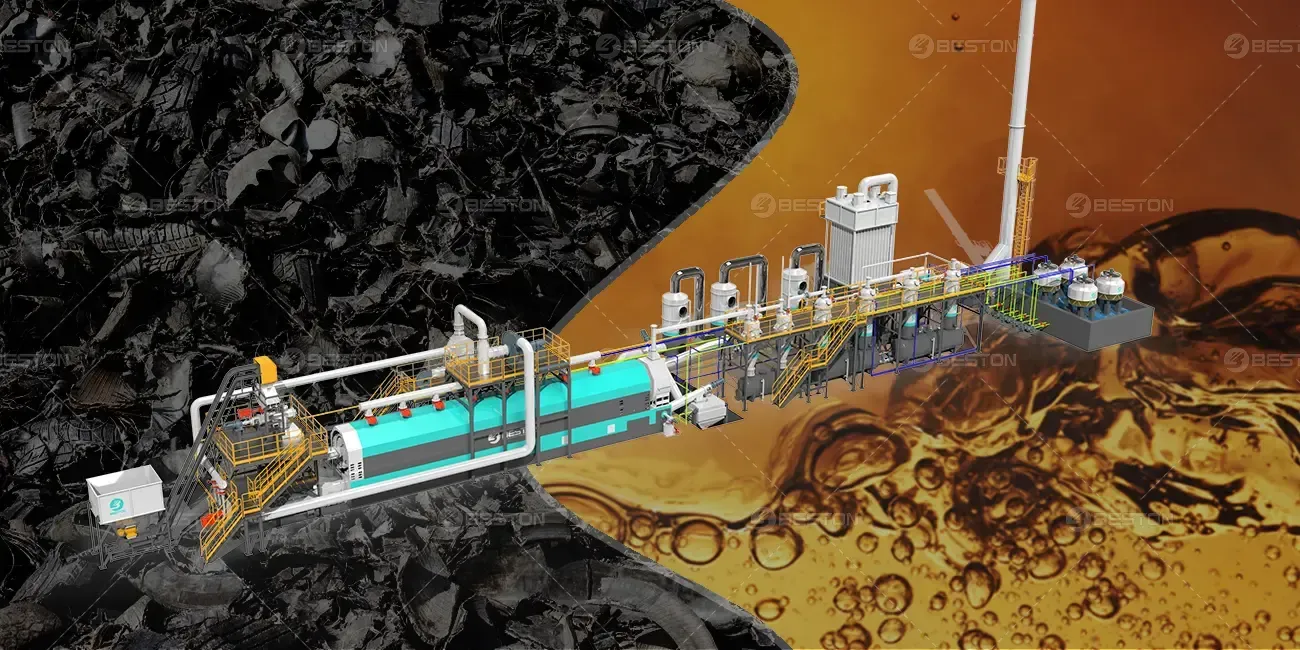Financial Impact of Investing in Tire Pyrolysis Plant
The tire pyrolysis process presents a profitable solution to the ever-growing waste tire disposal problem, with significant economic benefits. By converting used tires into valuable by-products such as pyrolysis oil, carbon black, and syngas, tire pyrolysis plants contribute not only to environmental sustainability but also to economic growth. These benefits manifest across various business operations, from reducing waste management costs to generating multiple streams of revenue. This article explores the financial implications and potential returns on investment (ROI) from establishing a tire pyrolysis plant.
Revenue Generation from By-Products
A well-optimized tire pyrolysis plant produces three primary by-products: pyrolysis oil, carbon black, and syngas. Each of these by-products has an established market value and offers substantial revenue potential.
- Pyrolysis Oil: The most commercially valuable product from the pyrolysis process is the bio-oil or pyrolysis oil, which can be refined and used as an alternative to traditional petroleum-based fuels. This oil has diverse applications in power generation, manufacturing, and as a raw material for the chemical industry. With rising demand for renewable energy sources, pyrolysis oil provides a significant avenue for revenue generation.
- Carbon Black: Carbon black, produced during the pyrolysis of tires, is another lucrative by-product. It is primarily used in industries like rubber manufacturing, electronics, coatings, and inks. The global demand for carbon black is growing, driven by its essential role in the production of tires and other rubber-based products. By selling carbon black to these industries, tire pyrolysis plant operators can generate additional revenue, creating a secondary profit stream alongside pyrolysis oil.
- Syngas: Syngas, a mixture of hydrogen, methane, carbon monoxide, and carbon dioxide, is another by-product of tire pyrolysis. Although it is typically used within the pyrolysis plant to provide energy for the process, excess syngas can be sold to local industries as a cheaper energy source. In some cases, it can even be converted into electricity, further enhancing the economic feasibility of the plant.
By tapping into these diverse revenue sources, tire pyrolysis plants can maximize their profit potential, reducing reliance on a single product while diversifying income streams.

Cost Savings through Waste Tire Processing
Waste tire disposal is a significant issue globally, with millions of tires discarded each year. Traditional methods, such as landfilling and incineration, are expensive and environmentally harmful. A tire pyrolysis plant provides a cost-effective solution for waste tire processing, which can lead to substantial cost savings for municipalities, waste management companies, and tire manufacturers.
- Reduced Landfill Costs: Tires are bulky and difficult to dispose of in landfills, often requiring significant space and resources. By converting tires into valuable products, a tire pyrolysis plant alleviates the need for large-scale tire landfills, reducing associated environmental cleanup and disposal costs.
- Lower Environmental Compliance Expenses: Waste tire incineration and landfill operations are subject to strict environmental regulations and penalties in many regions. A tire pyrolysis plant, on the other hand, provides a cleaner, more sustainable waste disposal method, minimizing regulatory costs and avoiding environmental fines. Moreover, the plant can potentially generate carbon credits, adding another source of income.
- Cost-Effective Energy Supply: Tire pyrolysis plants generate energy in the form of syngas, which can be used internally to power the plant. This reduces the need for external energy sources, lowering electricity costs. In some cases, excess syngas can be sold to nearby industries or converted into electricity for resale, further offsetting operational expenses.
Initial Investment and ROI
The initial cost of establishing a tire pyrolysis plant is a critical consideration for any investor. While the capital expenditure (CAPEX) required for purchasing equipment, setting up infrastructure, and ensuring regulatory compliance can be substantial, the long-term financial benefits justify the investment.
- Capital Cost Considerations: The cost of setting up a tire pyrolysis plant depends on various factors, including plant size, technology, location, and the scale of operations. While initial expenses may range from hundreds of thousands to millions of dollars, these costs can be recouped over time through the sale of by-products and savings on waste disposal.
- Return on Investment: The ROI for tire pyrolysis plants can be realized within 1 to 3 years, depending on factors like feedstock availability, product prices, and plant efficiency. The plant's ability to operate continuously without significant downtime, coupled with high-quality by-products, maximizes revenue potential and accelerates the payback period.
- Operational Efficiency and Profit Margins: Efficient plant design, automation, and optimized processing systems contribute to lower operational costs and higher profit margins. An increase in plant efficiency, achieved through better feedstock management, energy recovery systems, and automated processing, can significantly improve the profitability of a tire pyrolysis operation.
Market Demand and Price Fluctuations
The economic viability of a tire pyrolysis plant is also influenced by market demand and product price fluctuations. While the market for pyrolysis oil, carbon black, and syngas remains stable, global economic conditions, technological advances, and environmental policies can impact prices. Tire pyrolysis plant operators should remain adaptable to market trends and seek opportunities for product diversification to shield themselves from volatility.
- Biofuel Market Growth: As the world moves toward renewable energy sources, the demand for pyrolysis oil as a biofuel is expected to increase. Government incentives, subsidies, and stricter regulations on carbon emissions will likely drive higher demand for renewable fuel alternatives, boosting the profitability of the bio-oil produced by tire pyrolysis.
- Carbon Black Market Demand: The carbon black market is projected to expand due to its role in tire manufacturing and other industrial applications. An increase in tire production, as well as the adoption of carbon black in various sectors, will sustain demand for this product, ensuring consistent revenue generation for tire pyrolysis plants.
- Technological Advancements: Technological innovations in the pyrolysis process, such as improvements in energy efficiency, product quality, and by-product conversion, can increase the marketability of pyrolysis products. By staying at the forefront of technology, tire pyrolysis plant operators can capture a larger market share and improve profitability.



